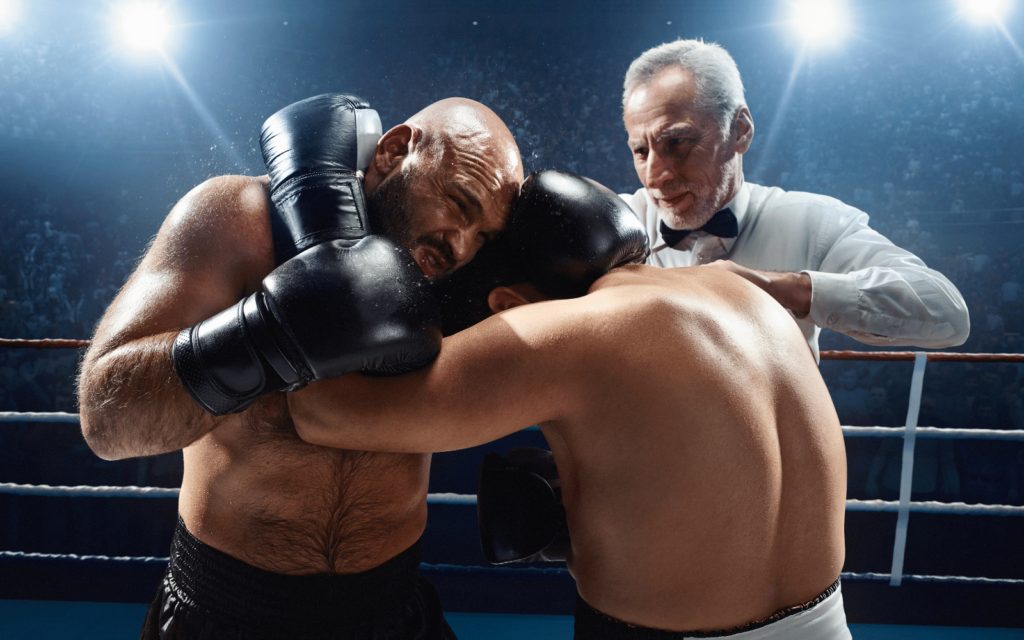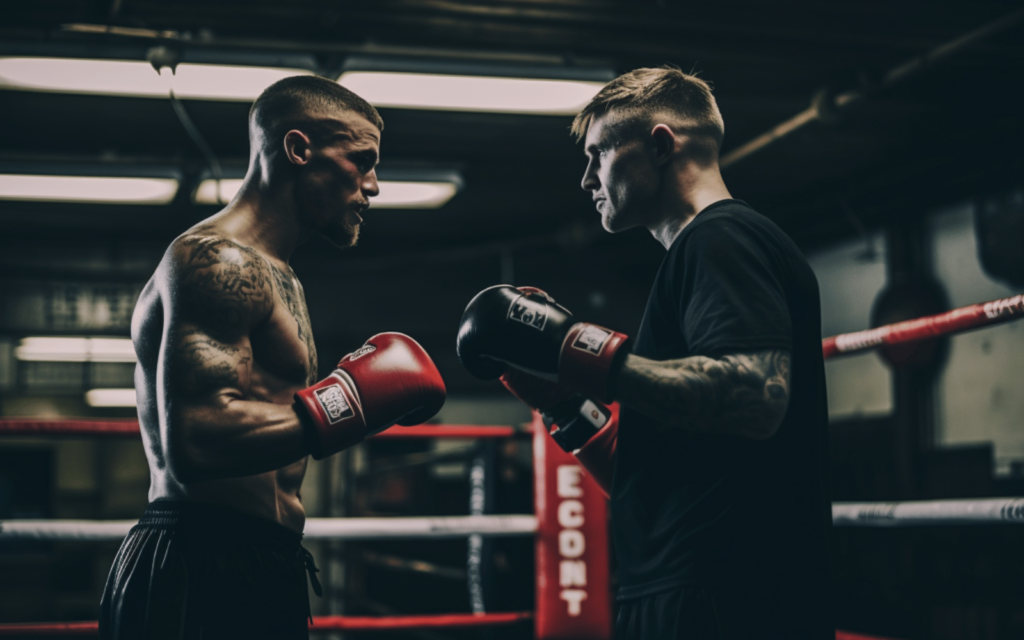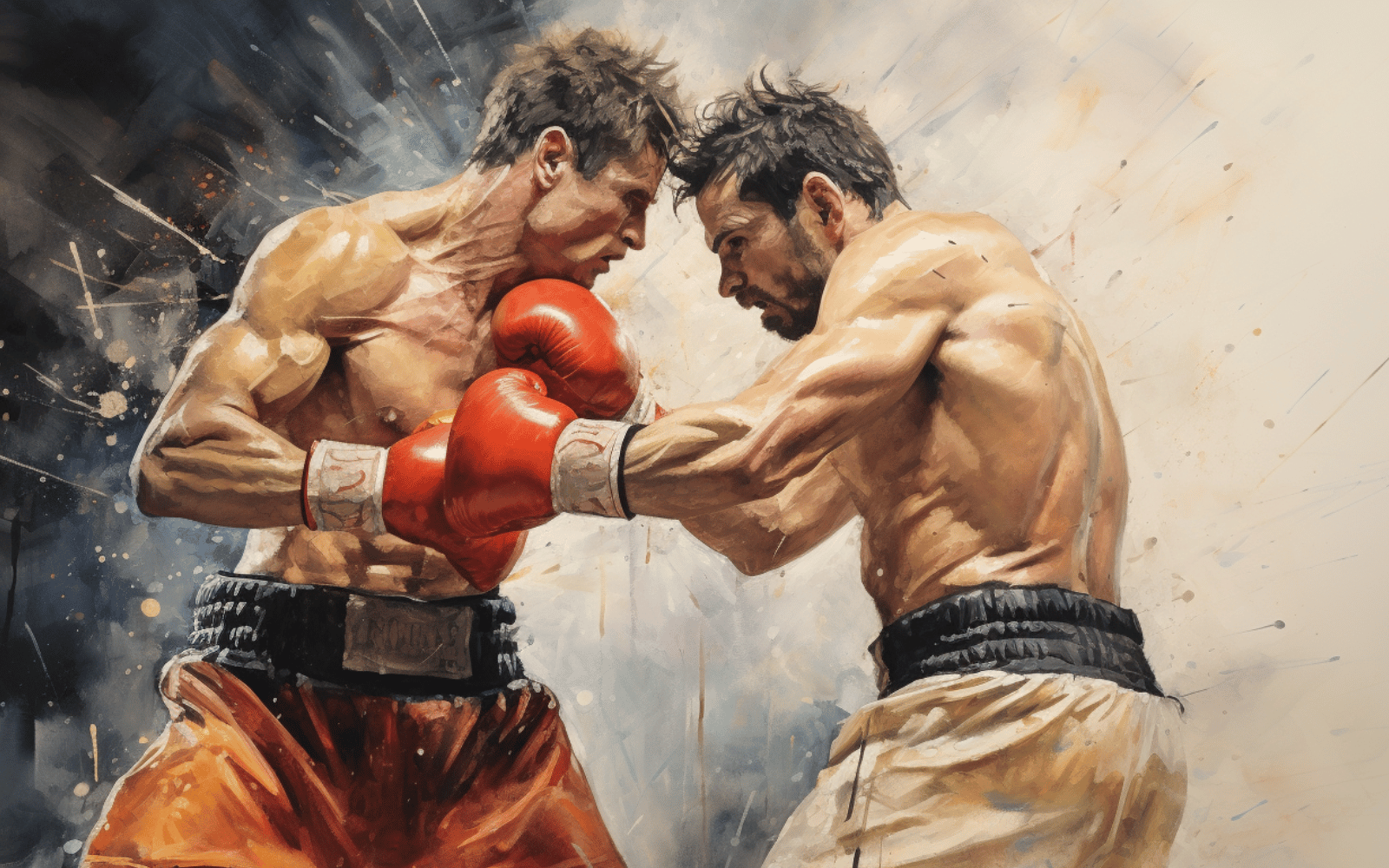Boxing enthusiasts often focus on the punches, footwork, and knockouts. And so, sometimes, clinching in boxing gets overlooked.
But we don’t think like that. We think a comprehensive view of the sweet science helps equip you with a full view of the sport.
So, in this article, we’ll take a deep dive into the fascinating world of clinching in boxing. We’ll cover:
- Its historical roots,
- Offensive and defensive techniques and strategies,
- And its pivotal role within the squared circle.
So let’s get started.
- What is Clinching in Boxing?
- Origins of Clinching in Boxing
- 9 Common Types of Clinching in Modern Boxing
- The Mechanics And Strategies of The Boxing Clinch
- Tips For Improving Your Clinch
- How to Defend The Clinch in Boxing
- Referee Control: A Vital Component
- Boxing In Clinching FAQ
- Does The Sport of Boxing Permit the Practice of Clinching?
- Can Excessive Clinching Lead to Point Deductions?
- Are There Renowned Boxers Celebrated For Their Clinching Skills?
- Do Punches in the Clinch Count For Points in Boxing?
- Why is Clinching Permitted in Boxing, and Should It Be Limited?
- How To Use The Clinch Effectively In Boxing?
- Can a Clinch Turn Around a Boxing Match?
- How To Effectively Utilize Clinching in Boxing?
- Clinching In Boxing In Conclusion
What is Clinching in Boxing?
Let’s start with an analogy…
Let’s say you’re dancing with a partner, and the song suddenly gets too fast or too intense, so you pull your partner close in an embrace to take a brief pause and catch your breath.
In that close hold, neither of you is moving much; you’re just waiting for the right moment to start dancing again.
In boxing, clinching is like that brief embrace.
When a boxer feels overwhelmed, tired, or needs a momentary break, they may grab or hold onto their opponent to prevent them from throwing punches.
It’s a strategy to slow down the action and regain composure or position momentarily. And just like dancers will return to their routine after their brief pause, boxers will break from the clinch and continue fighting once they’ve had that moment to reset.
Origins of Clinching in Boxing
Boxing, with two combatants squaring off, has been depicted in art as far back as 2400 BC in Ancient Mesopotamia.
But what about clinching?
Tracing Back to Ancient Roots
Clinching in boxing can be traced back to ancient civilizations like Greece and Rome.
In Olympic games that go way back to 648 BC, there was a really popular sport called Pankration (kinda similar to combat Sambo).
It was a mix of boxing and wrestling, with no strict rules besides no biting or gouging.
These warriors used to do some clinching, but it likely wasn’t as skillful as today’s techniques.
The Marquess of Queensberry Rules
We’re skipping ahead in time quite a bit.
But it wasn’t until the late 19th century when clinching in modern boxing began with the introduction of the Marquess of Queensberry Rules in 1867.
These rules eliminated wrestling. And they mandated that the referee break a clinch, marking a pivotal moment in the sport’s evolution.
9 Common Types of Clinching in Modern Boxing

There are a surprising number of different types of clinches you can see in boxing matches.
Overhook Clinch
One fighter hooks their arm over the opponent’s arm, typically locking it down by the elbow or tricep. This can effectively neutralize that arm, preventing it from throwing punches.
Underhook Clinch
One fighter places their arm under the opponent’s arm, seeking to lift or control it. This can control the opponent’s posture or set up short punches with the free hand.
The Bear Hug
Picture this: the bear hug, a classic move in boxing. It happens when one boxer wraps both arms really tight around the other boxer’s body. This stops the other boxers from using their arms to punch.
Head Tie
More of a common clinch in Muay Thai, one fighter uses a hand or forearm to control the back of the opponent’s head or neck.
This can pull the opponent down, making them more vulnerable, or steer them into punches (or knees and elbows in Muay Thai and Lethwei).
Double Arm Clinch
Both fighters wrap their arms around each other, typically around the arms or upper body. This type of clinch usually results in a stalemate where neither fighter can effectively punch.
The Headlock
Another prevalent clinching move involves securing a shorter opponent’s head under one’s arm – limiting their mobility and striking options.
The Controversial “Dirty Clinch”
While not endorsed in sportsmanship, some fighters resort to less-than-honorable tactics within the clinch, such as delivering low blows or using their head to discomfort their opponent.
Single Arm Clinch
One fighter holds onto the opponent with one arm while keeping the other free. This can be used to land short punches, especially to the body, with the free hand.
Cross-Arm Clinch
A fighter places one arm across the opponent’s chest or neck while holding onto the opposite shoulder or upper arm. This can create a barrier and control the opponent’s movement.
The Mechanics And Strategies of The Boxing Clinch
With this context in mind, let’s explore how clinching in boxing is used today.
A Defensive Chess Move
Clinching primarily serves as a defensive chess move.
As mentioned above, when boxers feel like they’re getting hit by their opponent and can’t keep up, they can start a clinch.
Clinching can be a masterstroke when facing a stronger or more aggressive adversary.
So, they’ll wrap their arms around their opponent’s body to make it harder for them to land punches (to avoid a KO or TKO shot).
And by clinching, a fighter can effectively tie up their opponent, neutralizing their strengths.
Resetting the Tempo with a Boxing Clinch Strategy
Clinching offers fighters a precious moment to reset the tempo of the match.
It’s akin to a timeout and allows a boxer to catch their breath, regain composure, and recalibrate their strategy.
Consistent clinching can even irk an opponent, disrupting their rhythm and prompting them to make errors born of frustration.
Fighting Inside the Trenches
When there’s a clinch, fighters are really close and fight in tight spaces.
They can use clever moves like quick punches to the body or uppercuts to the head to earn points or weaken opponents before the referee breaks them up.
The Setup for Devastating Counters
A well-timed clinch can be a prelude to devastating counterattacks. Boxers often employ the clinch to create openings for powerful hooks or uppercuts.
Tips For Improving Your Clinch
- Practice Timing: It’s crucial to recognize when to clinch. This could be when you’re hurt, tired, or need to disrupt your opponent’s rhythm. Timing your clinches right can make it an effective strategy.
- Hand Placement: Aim to control your opponent’s arms by going over or under them. If you can control even one of their arms, you can prevent many punches.
- Head Position: Keep your head tucked into your opponent’s shoulder or chest. This makes it harder for them to land clean uppercuts or hooks on you while in the clinch.
- Use Your Weight: If you’re bigger or stronger, use your weight to push or pull your opponent around, draining their energy. However, be careful not to push blatantly, as referees often warn or penalize for excessive pushing.
- Stay Active in the Clinch: A clinch doesn’t mean all action must stop. Work with short punches on the inside, like body shots, or try to reposition your opponent.
- Footwork: Make sure your feet are positioned in a way that provides balance. You don’t want to be pushed over or off balance easily. Also, you can use footwork to pivot and turn your opponent, putting them in a less favorable position.
- Exit Strategy: Plan your exit from the clinch. Whether spinning out to the side or pushing off and creating space for a punch, always have a strategy for what you’ll do once the clinch is broken.
- Strength and Conditioning: Specific exercises can help you be more dominant in the clinch. For instance, working on your grip strength can help you control your opponent’s arms better. Exercises that enhance your core strength can also be beneficial.
- Watch and Learn: Study boxers known for their inside work and clinching abilities. Understand how they position themselves, use the clinch strategically, and protect themselves while clinching.
- Drill with Partners: Practice makes perfect. Regularly clinching with partners of different sizes and skill levels will help you adapt and refine your technique.

How to Defend The Clinch in Boxing
Effective clinch defense is a skill unto itself.
Here are some important tips:
- Anticipate the Clinch: If you can sense when an opponent is looking to clinch, you can often prevent it by adjusting your distance or using angles.
- Step Back: As your opponent moves in to clinch, quickly take a step back. This creates space and can leave your opponent off-balance, giving you a chance to land a counter-punch.
- Pivot: When an opponent tries to clinch, pivot to the side, especially to the outside of their lead foot. This can position you at an angle where you can land punches while they’re still moving forward.
- The Uppercut: An uppercut can be an effective counter as your opponent moves in to clinch, especially if they’re dropping their head. It targets the chin, which is often exposed during a clinching attempt.
- Short Hooks: If you can sense the clinch coming, short hooks, especially to the body, can be effective. They can halt the opponent’s forward momentum and, if landed cleanly, can be very impactful.
- Forearm Barrier: Place your forearm across their neck or chest as your opponent moves in. This prevents them from getting close and can be used to push them back or off to the side.
- Lower Your Level: Dropping your weight down (bending your knees) can make it harder for your opponent to secure the clinch, and it can also position you for body shots.
- Keep Your Hands Inside: If the clinch is imminent, try to get your hands inside of your opponent’s. This gives you better control and can allow you to push them away or land short punches.
- Head Control: Using one hand behind your opponent’s head or neck can give you control, preventing them from pulling you into a clinch and allowing you to guide their head into a position for a counter strike.
- Body Shots: During the initial moments of a clinch, if one hand is free, target the opponent’s body with quick punches. These can sap their energy and make them think twice about clinching in the future.
- Stay Active: Even if you’re partially clinched, continue to work. Throw punches, try to reposition, and make it clear to the referee (and judges) that you’re the active fighter.
- Stay Upright: When in a clinch, try to maintain a straight back to stay upright. Slouching can put you in a vulnerable position where your opponent can exert more control over you.
- Keep Your Hands Free: Fight to keep the other free if your opponent clinches one of your arms. This allows you to defend yourself and throw punches or work to break the clinch.
- Hand Positioning: If an opponent is attempting to clinch, try placing your hands on the inside of theirs. This can give you more control and leverage in the clinch.
- Use Your Forearms and Elbows: Your forearms and elbows can be used defensively to create space or prevent your opponent from getting too close. For instance, a forearm against an opponent’s chest or neck can be a barrier.
- Pivot and Turn: Use your footwork to turn or pivot your opponent. If you can spin them around, you might find yourself in a more advantageous position, which can also disorient them momentarily.
- Head Position: Keeping your head in a safe position is vital. Tuck your chin and position your head to the side, under your opponent’s chin, or on their chest. This reduces the risk of uppercuts or short hooks.
- Strength and Conditioning: As with clinching, clinch defense can benefit from specific exercises. Strengthening your neck, for instance, can make it harder for opponents to manipulate your head in the clinch. Grip strength and core exercises can also be beneficial.
- Stay Calm and Breathe: It’s easy to get flustered in a clinch, especially if you’re not initiating it. That’s why staying calm, breathing, and thinking strategically about your next move is key. It’s also important to practice the clinch with different training partners and body types (and even with a punching bag/dummy like Century Bob).
Referee Control: A Vital Component
In contemporary boxing, the referee plays a pivotal role in overseeing clinches.
They must ensure that clinches do not prolong unnecessarily and that fighters break free cleanly.
Failure to adhere to these rules can result in point deductions or even disqualification.
Boxing In Clinching FAQ
Here are some answers to frequently asked questions you may be interested in!
Does The Sport of Boxing Permit the Practice of Clinching?
Clinching is legal in boxing but must be executed strategically and not prolonged.
Referees ensure that clinches serve a tactical purpose, like gaining a moment to reset, land a decent shot, or disrupt an opponent’s rhythm, rather than being used as stalling tactics.
Can Excessive Clinching Lead to Point Deductions?
Excessive clinching, whether in boxing, Muay Thai, or other
It can drain energy from the fight and lead to point deductions – again, if it’s deemed excessive holding.
Are There Renowned Boxers Celebrated For Their Clinching Skills?
Certainly, numerous famous boxers, including philly shell master Floyd Mayweather Jr., Guillermo Rigondeaux, and Lennox Lewis, are celebrated for their exceptional clinching skills, which contributed significantly to their defensive prowess and success.
Do Punches in the Clinch Count For Points in Boxing?
Punches thrown during a clinch can count for scoring if they are clean, effective, and legal. However, their visibility to the judges plays a role, as punches obscured by the clinch might not be seen and thus not scored.
While light taps might not be considered significant strikes, those that clearly meet their mark will count. Yet, it’s crucial to ensure punches adhere to legal target areas, as illegal punches to the back of the head or below the belt are fouls.
Ultimately, the subjectivity of judging means that scoring can vary based on a judge’s perspective and interpretation.
Why is Clinching Permitted in Boxing, and Should It Be Limited?
While clinching serves as an instinctual defensive move often witnessed in street fights, it significantly prolongs professional boxing matches, delivering the satisfying spectacles fans expect.
Nonetheless, it can be disheartening when boxers resort to repeated clinching as a means to secure a win, instead of engaging in a genuine contest, particularly when it seems they haven’t put in the necessary training for the bout.
How To Use The Clinch Effectively In Boxing?
Mastering the clinch in boxing disrupts opponents’ offense, making it a potent tool in various situations for both offense and defense.
And studying legends like Muhammad Ali and Lennox Lewis, who effectively used it, can provide a valuable edge.
Can a Clinch Turn Around a Boxing Match?
During their high-stakes bout, Jeff Horn and Manny Pacquiao locked themselves in intense exchanges.
Horn bravely coped with a nasty cut on his head, a swollen face, and moments of being on the brink, while Pacquiao grappled with the challenge of landing decisive punches.
The match reached a pivotal moment in Round 11 when a crucial clinch resulted in Horn receiving a warning for using his elbow on Pacquiao’s throat.
This incident underscored the sheer fierceness of the competition and the unwavering determination exhibited by both fighters.
How To Effectively Utilize Clinching in Boxing?
If you’re a boxer looking to improve your clinch game, you might find it beneficial to explore cross-training in Greco-Roman wrestling and incorporating some aspects of dirty boxing.
Boxing allows you to gain an advantage by using your body weight effectively once you’re in close quarters with your opponent.
Side Note:
Even training Muay Thai and MMA, where you can throw, trip, or use knees in the clinch, could help you develop some effective strategies, particularly for self-defense on the street.
Clinching In Boxing In Conclusion
So, as you can see, the boxing clinch takes a prominent role as a strategic foundation. It offers fighters a versatile tool for defense, recovery, gaining a tactical advantage, and executing an effective strategy.
For anyone looking to make their mark as a boxer, mastering the intricacies of the clinch in boxing is essential, as it often holds the key to success in the boxing ring.
